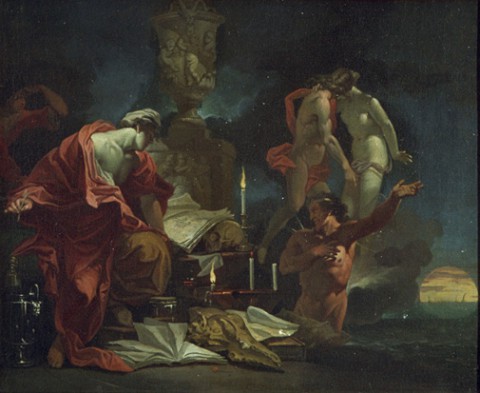Astrologer Observing the Autumnal Equinox and a Scene of Parting Adonis and Wenus
karta katalogowa kolekcji
Malarstwo
Dominicus van Wijnen a.k.a. Ascanius (1660-late 1690s)
Rome
end of the 17th century
oil, canvas
41 x 49 cm
Signature: ASCANIUS (on the sheet of paper in the bottom right-hand corner, next to the skull)
Wil. 1046
This sombre scene, where the only light comes from the candles, the setting sun and the rising moon, is one of the most notoriously obscurely mysterious works. This type of rebus painting was particularly fashionable in the Baroque period, especially among Roman artists. The Dutch painter Dominicus van Wijnen, who assumed the name of Ascanius after moving to Rome and jointing the fraternity of Dutch painters there, painted a large number of complex depictions that pose great demands on the viewer's erudition. The Wilanów painting, which is an allegory of the natural changes, depicts a young scholar wearing an Oriental turban (an astronomer or an astrologer, possibly a magus) lost in thought over a volume while observing an astronomical phenomenon. The scholar is visited by spectres of mythological lovers, Venus and Adonis. As decreed by Zeus, after Adonis' tragic death they could only spend half the year together, during spring and summer. Adonis had to spend the remaining time in Hades ruled by its queen Persephone. The clasping couple symbolizes the autumnal equinox, the moment of the lovers' parting and the coming of autumn and winter, a period of death in the realm of nature. Adonis' return in spring would be marked by a renaissance, a joyous time of renewed vegetation and natural fecundity. Charon the ferryman of the dead comes from the otherworld to collect Adonis, depicted as a naked and winged man emerging from the waves of the watery main. The two skulls, one human and one animal, are symbolic of the ultimate end of all living creatures. The sculpted decorations of the antique monument bearing a vase and lit by the rising moon likewise allude to the myth of Adonis. The vase probably depicts the moment of the birth (return?) of Adonis, depicted as a small child being helped up by putti (symbolic of emerging from Limbo or the world of the dead. Below, the panel of the sarcophagus depicts a man held (or led?) by two unidentified males of different age, who are probably related to the allegorical meaning of the composition and may be Thanatos and Hypnos or two genii. Both scenes may allude to the ancient feasts of Adonis celebrated in West Asia and on the eastern shores of the Mediterranean (known as the "Adonies" or the "Gardens of Adonis"). In recent scholarship, attention has been drawn to a less well-known of the myth related in Macrobius' Saturnalia and mentioned early in the 17th century by Karel van Mander in his commentaries on Ovid's Metamorphoses, which Ascanius may have been familiar with. The pages in the open volume perused by the scholar contain a diagram of constellations corresponding to the autumnal equinox (Libra). This symbol is complemented by the accompanying constellations of Hades or the Ferryman, shown as Charon, and Venus and Adonis. Those constellations could only be seen in the Orient (in the so-called Sphera Barbarica). Thus, it becomes highly likely that the scholar depicted in the painting is one Hipparchus of Nice, an ancient astronomer who lived in Asia Minor.
It is not known when Stanisław Kostka Potocki purchased this remarkable painting, first mentioned in a Wilanów catalogue in 1821 and mistakenly attributed to Gérard de Lairesse.
Krystyna Gutowska-Dudek

















